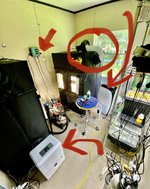A couple thoughts. Contrary to some opinions, after reading studies done at the Forest Products Lab at University of Wisconsin - Madison, For the vast majority of trees, 24 hours of light is "too much", it is wasteful. Increased daylength over 12 hours does result in increased growth, to a point. The magic number is 18 hours. Day cycles longer than 18 hours do not result in better or more growth. There is a "dark cycle" in photosynthesis, that does not require light. It does not require darkness, but it is the bottle neck for production of carbohydrates. THe health of the seedlings will benefit from having at least 4 hours of darkness per 24 hours in order to clear system of "backed up intermediate photosynthetic products". Plants do need a rest.
Item 2 - 5000 lumen is about equivalent to 1/4 to 1/2 outdoors sunlight. (much depends on distance from the plants where this is measured. Good enough quality to raise a wide range of trees. Here you can make up for low intensity by using the longer day length. But 24 hours is too long. Reduce day length to 18 hours. Do not reduce to match outdoor sunrise - sunset. You have seedlings, you want them to "think spring", want them to grow. Ideal day length for growth is 18 hours. Day lengths less than 12 hours are only used when trying to force dormancy. Less than 12 hours tells plants it is "winter".
Item 3 - fans. I keep a fan going 24 hours a day, 7 days a week. Even when ambient air is low humidity, the constantly moving air really helps to keep down pathogens, and insects. Results in healthy roots. And the moving air allows the leaves to be closer to the lamps without heat build up. Less issue with burning leaves if fans are on. Keeping fans on 24/7 will largely eliminate issues with damping off.
Fertilizer, yes you should fertilize after first true leaves become visible. I prefer dilute, but frequent. You do not have to be elaborate as CMeg1, Craig is over the top, near perfection in the way he grows seedlings. Commercial chemical fertilizers will work, a higher nitrogen number is preferred, I use a 12-1-4 with full complement of micronutrients. You can also go "organic", with fish emulsion and other organic nutrients. The kelp/humic acids are not fertilizer, but are very helpful. Do apply them the way Craig (
@cmeg1 ) suggests. He's got it right.
Raising seedlings does not have to be complicated. I would never go through the trouble of supplementing CO2, carbon dioxide. You can keep it simple. The 2 biggest issues with out of season, or winter sprouting of seed is insufficient light, and lack of air movement.
Have fun with your project.

